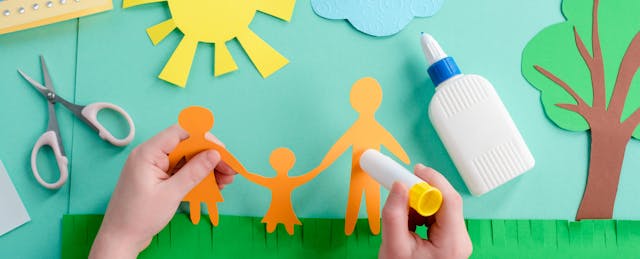When was the last time you said thanks?
Expressing gratitude with that one word may seem commonplace, perhaps even an afterthought. But research suggests that we say “thanks” much less often than we presume. The Australian researcher who led the study found that those who helped others were thanked in just one of 20 instances.
That’s not the case at Leadership Public Schools, a network of urban charter high schools in California, where gratitude is woven into the schoolwide culture. In classrooms, auditoriums and parent conferences, students and teachers publicly give shoutouts and thank one another for kindness and support.
Mike Fauteux, Leadership’s innovator-in-residence, says that expressing gratitude regularly helps create a more welcoming school environment, one that fosters a sense of belonging for students. “I fundamentally believe that building belonging in school is critical for wellbeing and achievement,” he tells EdSurge in an interview. “If you don’t feel like you belong, it’s awfully hard to feel good and succeed academically, establish relationships and build positive self-perception.”
But certain groups, he’s noticed, sometimes feel left out.
During class or at school-wide events, he says, “it was particularly challenging for ESL students, young men and shy students” to express gratitude towards others. In particular, young men he worked with “felt reluctant to open up because of issues of masculinity and assumptions around what it means to be a man.”
Fauteux, who started at Leadership in 2008 as a math teacher, found he was spending just as much time teaching social-emotional competencies as he was teaching math. In order for students to grow, he says, they need to “open up, be vulnerable, make mistakes and know they can reach out to others for help.”
Saying thanks may seem like a tiny piece of the larger puzzle for schools to provide emotional supports. But because it’s a quick, simple act, Fauteux believes gratitude can be easily woven as a daily habit in any classroom, regardless of the subject matter.
So he built an online tool, GiveThx, that provides a structured way for teachers and students to practice expressing gratitude through peer feedback and reflection. The mobile and web platform is straightforward: students log in and write a short thank-you note for one of their classmates.

GiveThx offers teachers guidelines for running gratitude exercises, all of which are designed to take less than 5 minutes, 3 times per week. Students can pick an individual classmate to thank. Or, if they’re working in a group, they can write a thank-you note to their teammates at the end of the activity. There’s also the “gratitude wave,” where teachers can select one student (either deliberately or at random), to whom everyone else in the class will write a thank-you note. And teachers can designate a theme for students to organize their notes around like empathy, patience or understanding.
Educators can view a dashboard that shows the distribution and frequency of thank-you notes that have been sent. Students can also see all the notes they’ve received, which “helps build a positive sense of self, particularly for those who have behavioral issues or low academic achievement,” says Fauteux. “Instead of focusing on all the things they’re doing wrong, we hope that they can also get evidence from their peers of their positive behaviors.”
At the end of each week, teachers set aside a short block of time for students to write weekly reflections. The point of GiveThx isn’t to accrue the most thank-you notes, says Fauteux, but for students to become more self-aware of their relationships with one another. In these journals, they can reflect on one specific message, or review all the notes and think about their strengths and growth areas, and how they made an impact on their classmates.

Giacomo Bono, an associate psychology professor at Cal State University at Dominguez Hills and an advisor to GiveThx, tells EdSurge he believes “gratitude is the gateway behavior to social-emotional competence.” He’s co-authored a report that even suggests that gratitude can be correlated with higher grades, life satisfaction and social integration, and lower envy and depression.
Bono, who also leads the Youth Gratitude Project, is wrapping up a study on the use of GiveThx in schools, which he and Fauteux will be presenting at the Society for Research in Child Development’s Character Development conference next month and seeking to publish in 2019. Preliminary findings, he says, “suggest that mental health, wellbeing and gratitude are all connected and reinforced by one another.”
Jennifer Saarinen, a seventh-grade teacher at Kickemuit Middle School in Rhode Island, learned about Fauteux’s work at an education technology conference in Rhode Island earlier this spring, and piloted GiveThx to the 85 seventh-grade students across her classes. She says that the exercises help students connect with peers who they normally don’t interact much with. “It also helped me see that there were connections between students that I didn’t know existed.”
Last fall, Rhode Island adopted statewide standards for social-emotional learning, and schools like Saarinen’s have begun a push to implement mindfulness activities and other SEL-support tools. She also uses GiveThx sends positive reinforcement messages to her students, and they reciprocate. “It’s important for students to recognize they have a relationship with their teachers beyond the subject area, especially if they don’t have anyone else outside of home to relate to.”
GiveThx was initially designed for middle- and high-school students. But the tool has also found a receptive audience at the younger levels. Suzanne Short, a second-grade teacher at All Souls Catholic School in South San Francisco, piloted the tool with 32 students this April. She had her students use the platform to give thanks to their peers everyday, after their daily 1pm prayer. “It’s connecting technology, curriculum and religion,” she says, “which is probably not what it was built for.”
For young children, Short believes these gratitude exercises are important in building empathy and self-awareness. Second-graders, she says, “are still pretty egocentric and think mostly about themselves. But being aware of how you make others feel is very important. It helps them realize their impact on others, and connect with the community.” For the current academic year, Short says GiveThx will be rolled out across all students in grades two to eight.
Saarinen wants to take it another step further: having the teaching staff use the tool to thank one another. “It’s hard to preach something if you’re not practicing it yourself,” she says.


